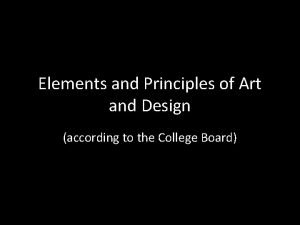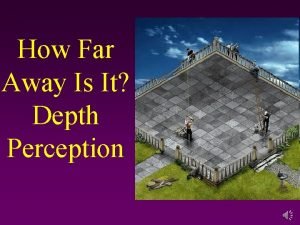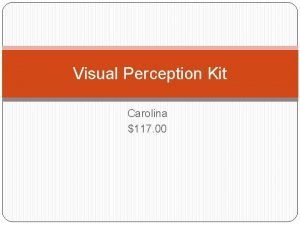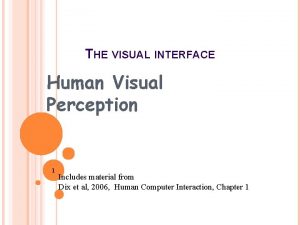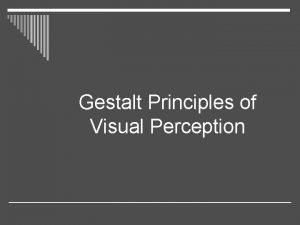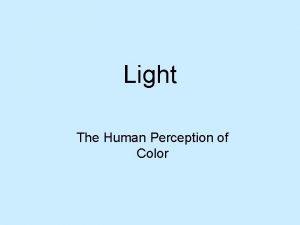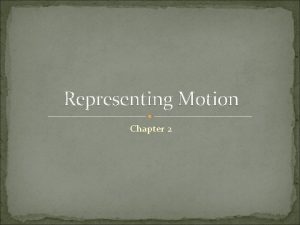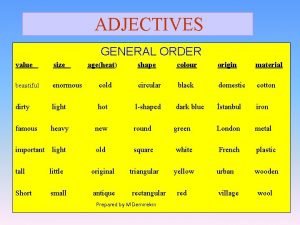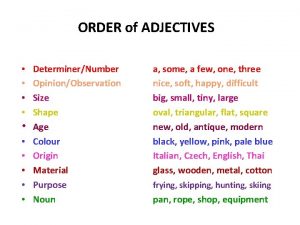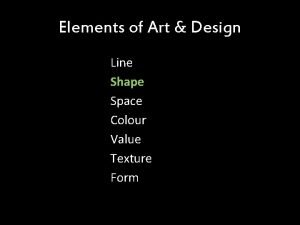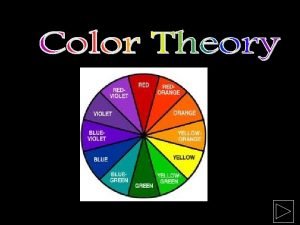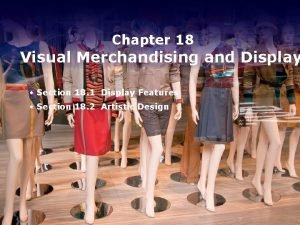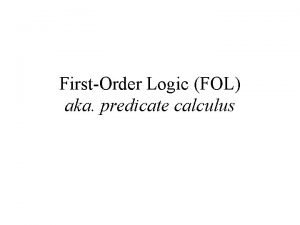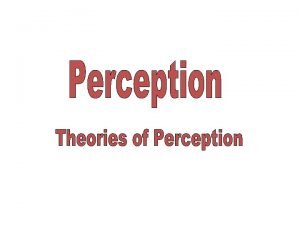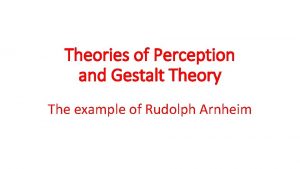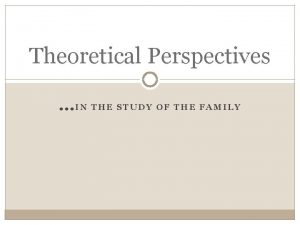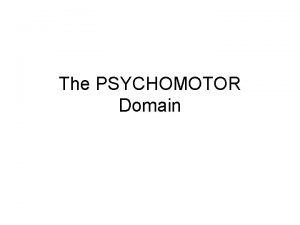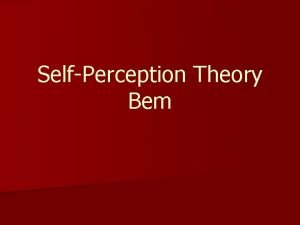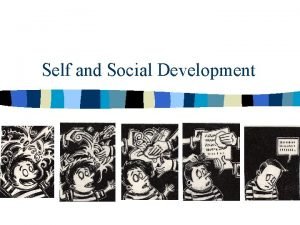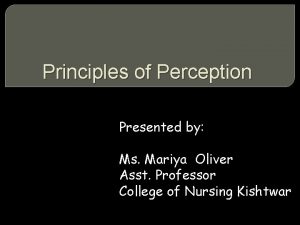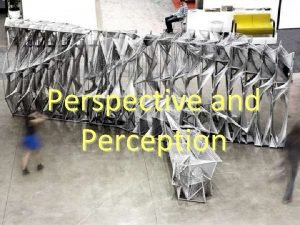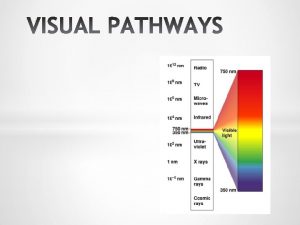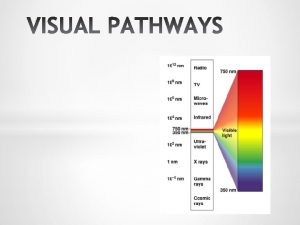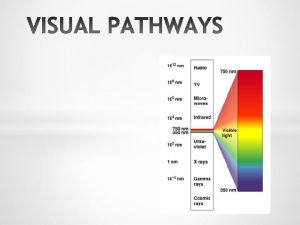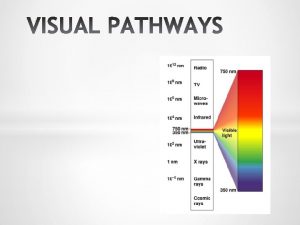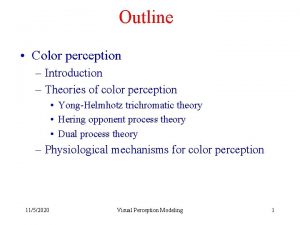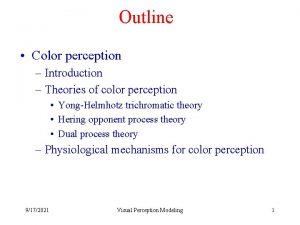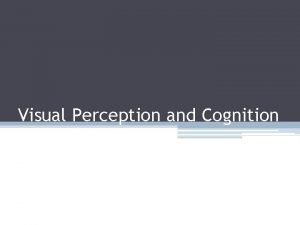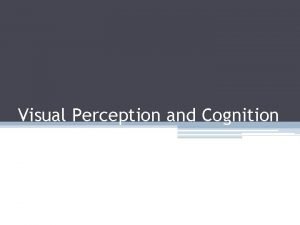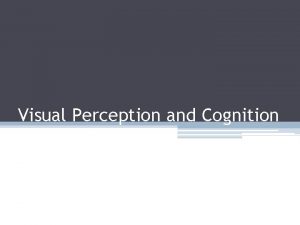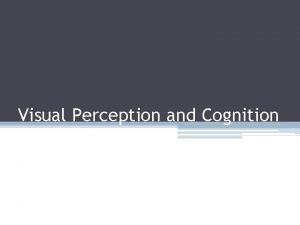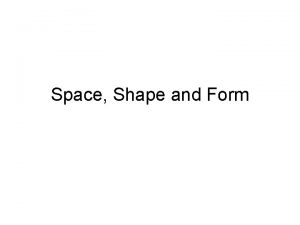VISUAL SYSTEM q Perception of shape motion color




















































- Slides: 52


VISUAL SYSTEM q Perception of Ø shape Ø motion Ø color q Two pathways Ø retina – cortex • visual perception retina – brainstem, diencephalon Ø • • eye movements circadian photoentrainment accommodation pupillary reflexes

Light passes through the cornea, aqueous humor, lens, and vitreous body to form an image on the retina.

Macula lutea + fovea centralis = areas of the highest visual acuity Fundus oculi

RETINA 10 layers: mainly separated by cell bodies (nuclear layers) and axons (plexiform layers)

q 5 main cell types: § photoreceptors § bipolar cells § horizontal cells § amacrine cells § ganglion cells q Photoreceptors: § rods and cones § involved in transduction converting the light signal into a nerve impulse

q neurons with serial (vertical) connection § the main visual pathway § photoreceptors → bipolar cells → ganglion cells q neurons with parallel (horizontal) connection § modulation of the visual information by retina § horizontal cells § amacrine cells


q Cones (7 million) § cluster at fovea (macula lutea) § detect color in bright light = photopic vision q Rods (100 million) § outside the fovea § sensitive to shape and movement = scotopic vision

CONES q 3 different types with three different photopigments: blue, green and red q Each type is maximally sensitive to the wavelength that corresponds to the specific color range (spectral sensitivity)

GANGLION CELLS q P cells (80%) § ganglion cells that monitor cones § smaller, more numerous § axons end on parvocellular laminae of LGN § provide information about fine detail and color q M cells (10%) § ganglion cells that monitor rods § relatively large § axons end on magnocellular laminae of LGN § provide information about a general form of an object, motion, and shadows in dim light q non-P non-M cells (10%) § projection to subcortical nuclei, koniocellular cells of LGN

PRIMARY VISUAL PATHWAY q The primary visual pathway connects the retina with lateral geniculate nucleus and primary visual cortex (retinogeniculostriate pathway) q It is responsible for detection of shape, movement and color Primary visual cortex 1 st neuron (photoreceptors) 2 nd neuron (bipolar cells) Optic tract CN II 3 rd neuron (ganglion cells) Optic radiation Optic chiasm LGN


LATERAL GENICULATE NUCLEUS (LGN) q LGN is composed of 6 layers q Layers 1 and 2 contain larger neurons q Layers 3 - 6 contain smaller neurons


q Ipsilateral input enters layers 2, 3 and 5 q Contralateral input enters layers 1, 4 and 6

q LGN contains the topographic representation of what the retina “ sees”. This retinotopic map is sent to the cortex. q LGN modulates and regulates the flow of visual information to the primary visual cortex q cortex can control efficiency of thalamic input

GENICULOSTRIATE PATHWAY optic radiation (geniculocalcarine fibres) runs under the temporal lobe to the occipital lobe

RETINOTOPIC REPRESENTATION q Nasal and temporal visual fields q Reversed to opposite halves of retinal representative fields (hemiretinas) q Inverted and reversed q Nasal visual fields project to temporal hemiretinas and their axons do not cross at the optic chiasm q Temporal visual fields project to nasal hemiretinas and their axons cross at the optic chiasm


RETINOTOPY q Most of the visual field is shared by the two eyes (binocular field) q Representation of different parts of the visual field is disproportionate in size

VISUAL CORTEX

PRIMARY VISUAL CORTEX (V 1) q Most LGN axons terminate in V 1 q All V 1 neurons respond to visual stimuli exclusively q Ablating V 1 results in blindness in the contralesional hemifield (homonymous hemianopsia) q Electrical stimulation of V 1 elicits visual sensations

VISUAL ASSOCIATION CORTEX Dorsal Stream Ø spatial orientation Ø binocular fusion/depth perception Ø the location, the movement and the movement direction and velocity of objects in space Ventral Stream Ø recognize objects and colors Ø read text Ø learn and remember visual objects (e. g. , words and their meanings)

VISUAL PATHWAYS TO SUBCORTICAL STRUCTURES q to the suprachiasmatic nucleus of hypothalamus q to the pretectum of the midbrain q to the superior colliculus

1 st order neuron § bipolar neuron of the spiral ganglion § dendrites make synapses with hair cells § axons form the cochlear part of CN VIII

2 nd order neuron § ventral cochlear nucleus → trapezoid body → lateral lemniscus § dorsal cochlear nucleus → lateral lemniscus 3 rd order neuron § nucleus of inferior colliculus → brachium c. i. 4 th order neuron § medial geniculate nucleus → radiatio acustica (internal capsule)


PRIMARY AUDITORY CORTEX gyrus temporalis superior (gyri temporales transversi of Heschl) - area 41 + 42

Two functionally significant features: q tonotopical organization q bilateral projection

DESCENDING PATHWAYS q feedback system processing ascending information q enhance signals q supress noise q mainly functions of the superior olivary complex q focus on a particular speaker and inhibit other voices

q changes in the motion of the head (kinetic) and in the position of the head with respect to gravity (static) q 3 afferent sources: the eyes, general proprioceptive receptors throughout the body, and the vestibular receptors in the inner ear q to maintain equilibrium, to direct the gaze of the eyes, and to preserve a constant plane of vision

VESTIBULAR APPARATUS q Labyrinth of static apparatus § macula utriculi – orientation in horizontal position § macula sacculi – orientation in vertical position q Labyrinth of kinetic apparatus § cristae ampullares of semicircular ducts

q Hair cells in the maculae of the saccule and the utricle respond to linear acceleration (gravity). q Hair cells in the cristae ampullares in the semicircular ducts respond to angular acceleration (rotation of the head).

VESTIBULAR PATHWAY q 1 st order neuron – vestibular ganglion (utriculoampullar nerve, saccular nerve, posterior ampullar nerve) q 2 nd order neuron – vestibular nuclei (superior, inferior, medial, lateral)



Connections with the cerebellum q vestibular portion of the CN VIII – inferior cerebellar peduncles – ipsilateral vestibulocerebellum q vestibular nuclei – inferior cerebellar peduncles – vestibulocerebellum maintenance of balance

Connections with the spinal cord to motoneurons that innervate axial and proximal limb muscles q lateral vestibulospinal tract § from lateral vestibular nucleus § uncrossed § terminating at all levels of the spinal cord § excitatory influences for extensors q medial vestibulospinal tract § from medial vestibular nucleus § uncrossed § descends in the MLF § terminates mainly at cervical levels § coordination of head position and eye movements

Connections with the brain stem q ascending portion of MLF Ø CN III, IV, VI Ø Darkschewitsch and Cajal nuclei Ø coordination of eye movements in response to head movements

Connection with the thalamus (cortex) conscious perception of movement and gravity

Olfactory region

1 st order neuron – bipolar olfactory neurons 2 nd order neuron – mitral cells – olfactory tract

3 rd order neuron – olfactory tubercle 4 th order neuron – dorsomedial nucleus of thalamus Orbitofrontal cortex (perception of olfactory information)


Taste buds q receptor cells (replaced about every 9 -10 days by differentiating basal cells) q supportive columnar cells q basal cells


1 st order neuron – § CN VII –geniculate ganglion Ø via lingual nerve and chorda tympani Ø via greater petrosal nerve § CN IX – inferior ganglion of CN IX § CN X – inferior ganglion of CN X

2 nd order neuron - rostral part of the solitary nucleus 3 rd order neuron – ventral posteromedial nucleus of thalamus

Primary gustatory cortex q a. 43 in the postcentral gyrus q insula


Illustrations were copied from: Neuroscience Online, the Open-Access Neuroscience Electronic Textbook.
 A feeling of visual equality
A feeling of visual equality The feeling of harmony between all parts of the artwork
The feeling of harmony between all parts of the artwork Monocular cues relative height
Monocular cues relative height Gestalt principles of sensation and perception
Gestalt principles of sensation and perception Carolina visual perception kit
Carolina visual perception kit Visual perception in hci
Visual perception in hci Gestalt principles of visual perception
Gestalt principles of visual perception Color perception examples
Color perception examples Drag divergence mach number
Drag divergence mach number Shape matching and object recognition using shape contexts
Shape matching and object recognition using shape contexts Bolongie
Bolongie Types of motion
Types of motion Harmonic equation physics
Harmonic equation physics An object in motion stays in motion
An object in motion stays in motion Chapter 2 motion section 1 describing motion answer key
Chapter 2 motion section 1 describing motion answer key Describing and measuring motion
Describing and measuring motion Section 1 describing motion
Section 1 describing motion Section 1 describing motion worksheet answer key
Section 1 describing motion worksheet answer key Motion section 1 describing motion
Motion section 1 describing motion Picturing motion
Picturing motion Pemrograman konvensional adalah
Pemrograman konvensional adalah Line shape texture
Line shape texture Adjectives opinion size shape age texture color material
Adjectives opinion size shape age texture color material Opinion size age shape color
Opinion size age shape color Size shape color texture
Size shape color texture Art line color
Art line color Line shape form space color value texture
Line shape form space color value texture Polygon drawings line color value texture shape space form
Polygon drawings line color value texture shape space form Form element of art
Form element of art Color shape and texture are what properties
Color shape and texture are what properties What shape and color are the whmis 2015 symbols
What shape and color are the whmis 2015 symbols Line shape form color texture space
Line shape form color texture space Using in order to in a sentence
Using in order to in a sentence Color in motion maria claudia cortes
Color in motion maria claudia cortes Visual elements - light and color
Visual elements - light and color Chapter 18 visual merchandising and display
Chapter 18 visual merchandising and display Modus ponens example
Modus ponens example Gregory top down theory of perception
Gregory top down theory of perception Film als kunst
Film als kunst Perspective vs perception
Perspective vs perception Perception in psychomotor domain
Perception in psychomotor domain Objective perception
Objective perception Nature of perception
Nature of perception Bem's self perception theory
Bem's self perception theory Self image vs self perception
Self image vs self perception Is having a clear perception of your personality
Is having a clear perception of your personality Self concept goals
Self concept goals Self concept vs self esteem
Self concept vs self esteem Chapter 5 sensation and perception
Chapter 5 sensation and perception Principle of context
Principle of context Perspective quotes
Perspective quotes Interpersonal perception
Interpersonal perception What does the word perception mean
What does the word perception mean
